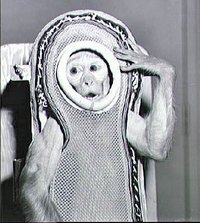Monkeys in space
|
|
Before humans were launched into space, several animals, including numerous monkeys, were used to investigate the biological effects of space travel. The United States launched monkey flights primarily between 1948 and 1961 with one flight in 1969 and one in 1985. France launched two monkey space flights in 1967. The Soviet Union and Russia launched monkeys between 1983 and 1996. Most monkeys were anesthetized before lift-off. Thirty-two monkeys flew in the space program, each had only one mission. Numerous back-up monkeys also went through the programs but never flew. Monkeys from several species were used, including rhesus, cynomolgus, squirrel, and Philippine monkeys as well as pigtailed macaques.
| Contents [hide] |
United States
The first monkey astronaut was Albert, a rhesus monkey, who on June 11, 1948 rode to over 63 km (39 miles) on a V2 rocket. Albert died of suffocation during the flight.
Albert was followed by Albert II who survived the V2 flight but died on impact on June 14, 1949. Albert II became the first monkey in space as his flight reached 134 km (83 miles). Albert III died at 35,000 feet (10.7 km) in an explosion of his V2 on September 16, 1949. Albert IV on the last monkey V2 flight died on impact on December 8 that year. Albert II and Albert IV were rhesus monkeys while Albert III was a cynomolgus monkey.
Monkeys later flew on Aerobee rockets. On April 18, 1951, a monkey, possibly called Albert V died due to parachute failure. Yorick, also called Albert VI, along with 11 mice crewmates became the first animals to survive spaceflight but he died 2 hours after landing. Patricia and Mike, two Philippine monkeys, flew on May 21, 1952 and survived but their flight was only to 26 kilometers, below the definition of space at 100 kilometers.
On December 13, 1958 Gordo, also called Old Reliable, a squirrel monkey, survived being launched aboard JUPITER AM-13 by the USA Army. He died because of a mechanical failure of the parachute recovery system in the rocket nosecone.
On May 28, 1959 Able, a rhesus monkey, and Baker, a squirrel monkey, became the first living beings to successfully return to Earth after traveling in space aboard the JUPITER AM-18. They travelled in excess of 16,000 km/h, and withstood 38 g (373 m/s²). Able died June 1, 1959 while having surgery to remove electrodes from the mission. Baker lived until 1984.
In 1959, Sam, a rhesus monkey flew on the Little Joe 2 flight in the Mercury program followed in 1960 by Miss Sam, also a rhesus monkey on Little Joe 1B (Ham and Enos also flew in the Mercury program but they were chimpanzees not monkeys).
Goliath, a squirrel monkey died in the explosion of his Atlas rocket on November 10, 1961. A rhesus monkey called Scatback flew a sub-orbital flight on December 20, 1961 but was lost at sea after landing.
Bonny, a pigtailed macaque, flew on Biosatellite 3, a mission which lasted from 29 June to 8 July, 1969. This was the first multi-day monkey flight - but came after longer human spaceflights were common. He died within a day of landing.
Spacelab 3 on the Space Shuttle flight STS-51B featured two squirrel monkeys named No. 3165 and No. 384-80. The flight was from 29 April - 6 May, 1985.
France
France launched a pigtailed macaque named Martine on a Vesta rocket on March 7, 1967 and another named Pierette on March 13. Both survived their trips.
Soviet Union/Russia
The Soviet/Russian space program in the Bion program satellites used only the rhesus species.
The first Soviet monkeys, Abrek and Bion, flew on Bion 6. They were aloft from December 14, 1983 - December 20, 1983.
Next came Bion 7 with monkeys Verny and Gordy from July 10, 1985 - July 17, 1985. Then Drema and Yerosha on Bion 8 from September 29, 1987 - October 12, 1987.
Bion 9 with monkeys Zhakonya and Zabiyaka followed from September 15, 1989 to September 28, 1989. They hold the monkey in space endurance record at 13 days, 17 hours in space. Monkeys Krosh and Ivasha flew on Bion 10 from December 29, 1992 to January 7, 1993. Lapik and Multik are the last space monkeys to date. They flew aboard the Bion 11 mission from December 24, 1996 to January 7, 1997. Multik died soon after landing.
See also
External link
- Monkey astronauts (http://www.planet4589.org/space/book/astronauts/astronaut/bio/primate.html)

